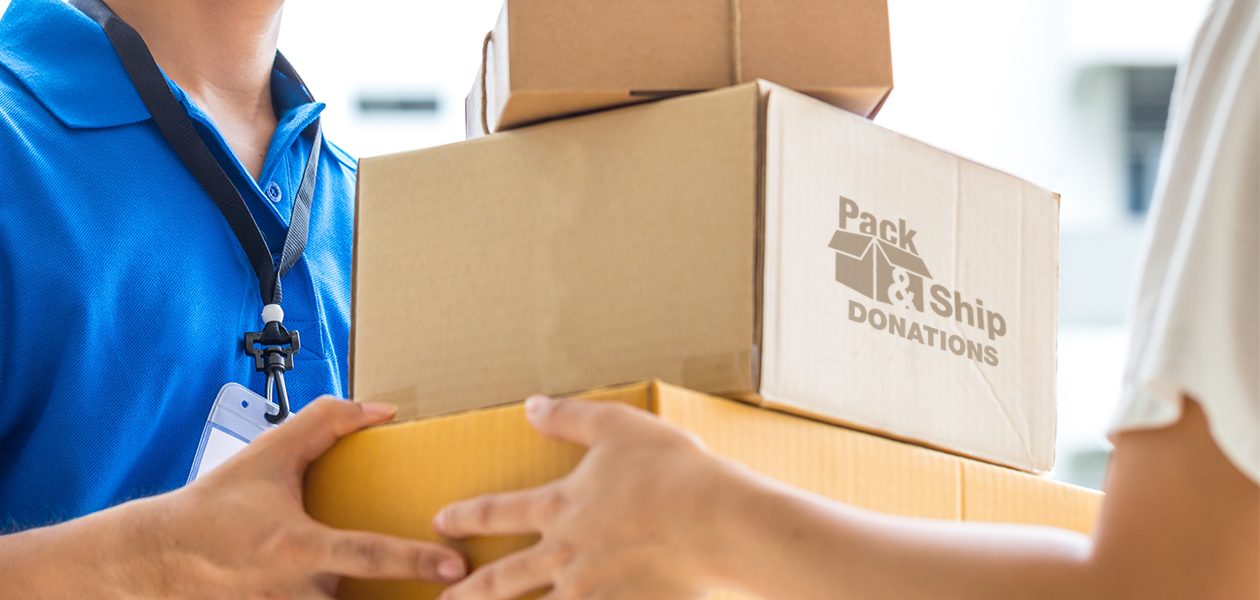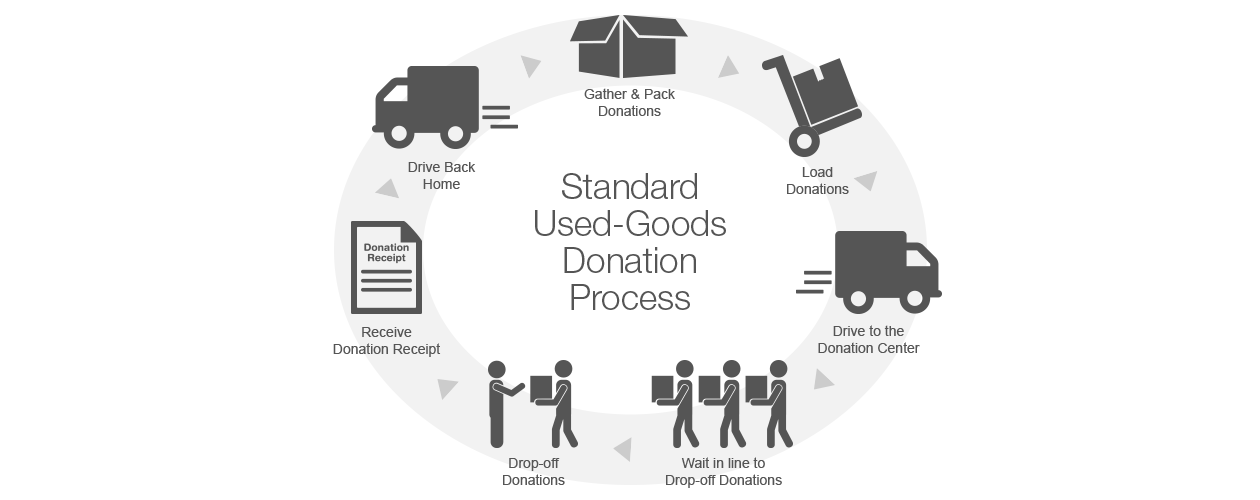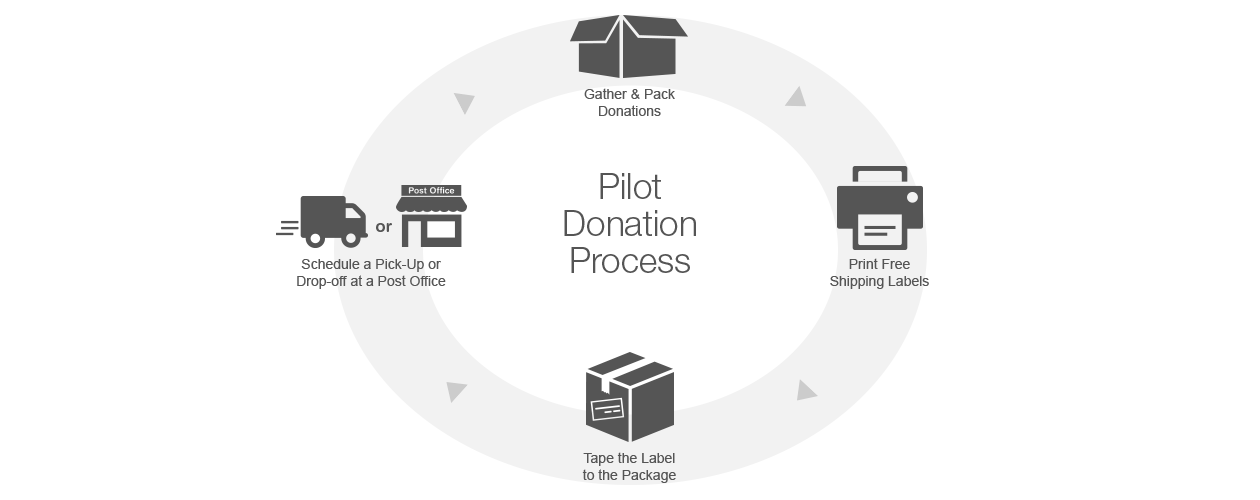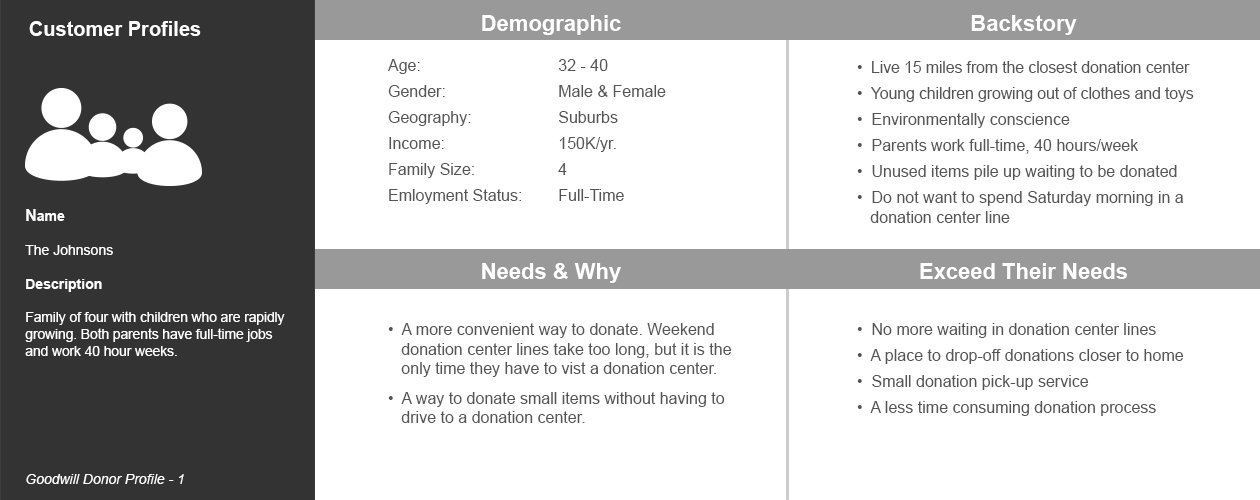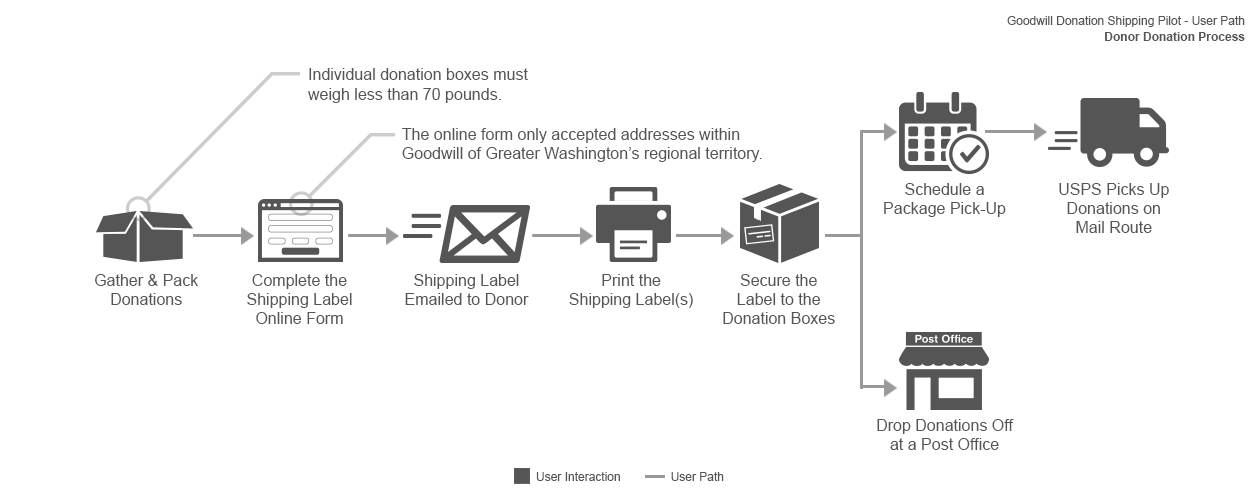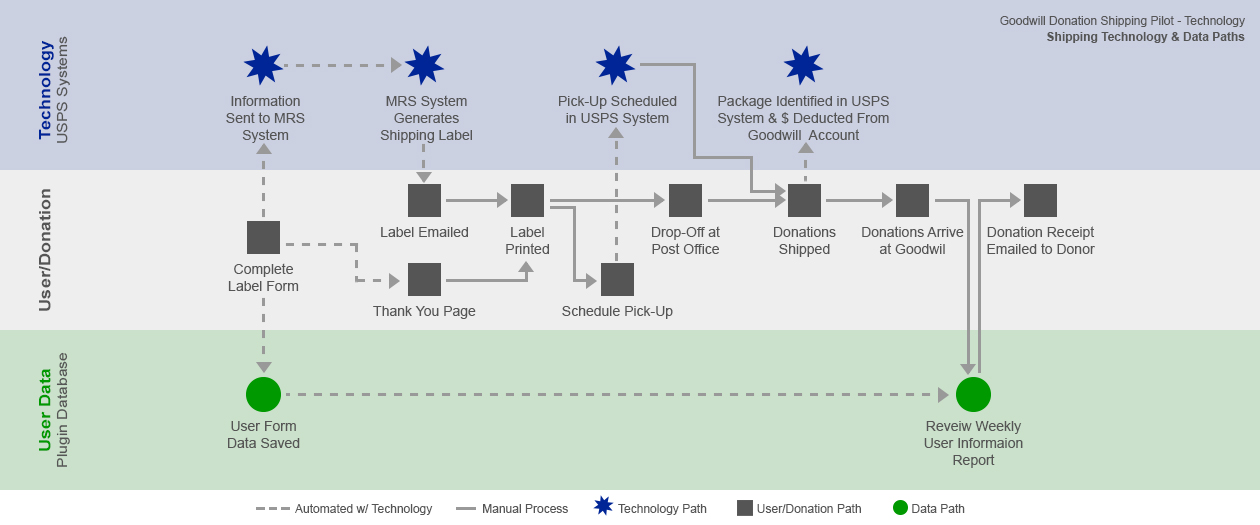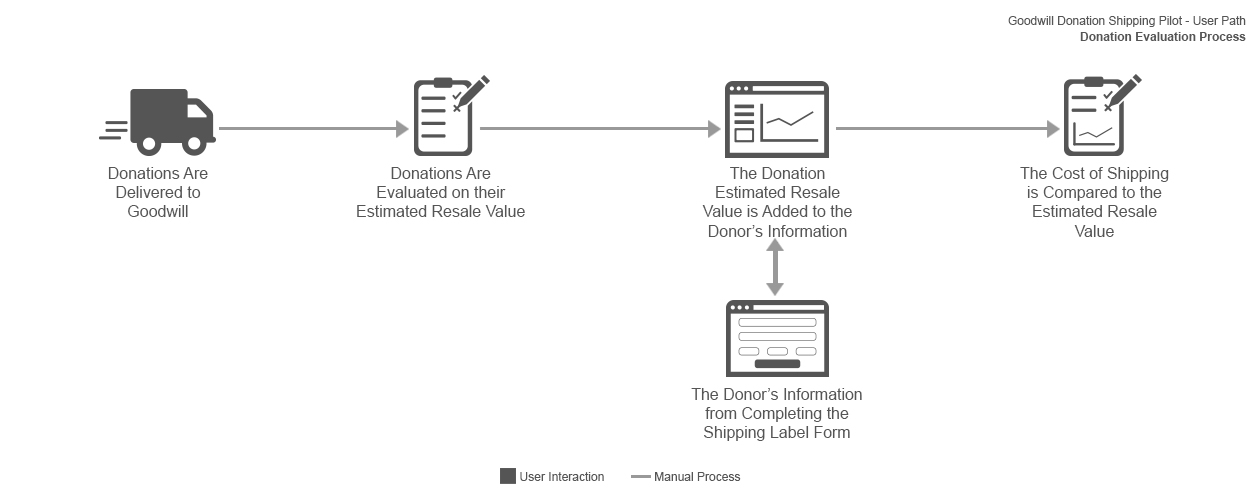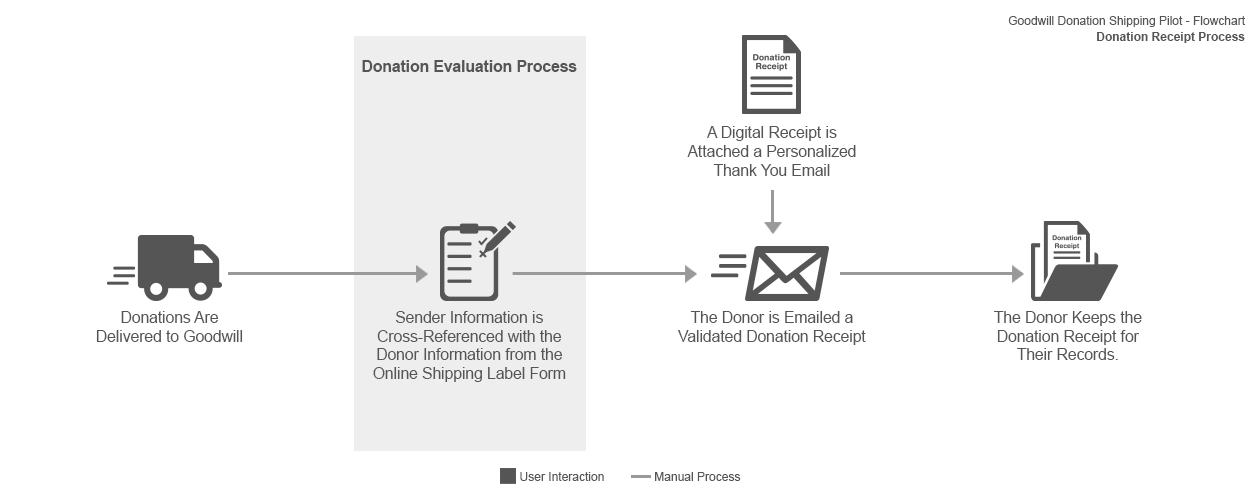My Role User Experience & System IntegrationMy responsibilities combined the roles of a User Experience Designer and a Project Manager. I led the research team to find a suitable vendor for the delivery segment of the service and identify customer demographics. Next, I focused the teams’ efforts on integrating each phase of the process so customer needs were met.
Throughout the project, I managed relationships with critical third party vendors. I coordinated with the United States Postal Service (USPS) to understand and implement their Merchandise Return Service (MRS) system. I also worked closely with a web development agency who had experience in customizing the USPS MRS Application Programming Interface (API).
By taking on the roles of a Designer and a Project Manager, I was able to manage this project with an in-depth understanding from research to development.
The Vision Donor ConveniencePeople like donating their unwanted goods to non-profit organizations because they want to support a good cause. The process of donating can be time-consuming and labor-intensive, so most people make it to a donation center once- or twice-a-year.
This diagram illustrates the time-consuming process that is involved with donating used goods.
The purpose of this pilot is to give donors an alternative method to donate that is more convenient and less time-consuming. The pilot gives donors the option to ship small- and medium-sized donations for free via a home pick-up or by dropping them off at their local post office.
This diagram illustrates the pilot’s simplified donation process. The donor’s time is saved by not having to wait in line and travel to and from a donation center.
This pilot benefits both donors and the organization. The donor still can donate to Goodwill, but without having to drive to a donation center and wait in line. Goodwill would be able to receive donations from a demographic of donors who are unable or unwilling to drive to a donation center. We also hoped donors would donate more frequently if there was a less time-consuming option to donate.
My goal was to integrate complex systems to provide the donor with a seamless user experience.
Defining The Customer Shared NeedsWhen identifying the donor profiles, I noticed a recurring challenge that was showing up in almost all of the profiles. These challenges shared a theme of not having a large enough donation to justify the time it takes to travel to a donation center.
Profiles like this helped identify the donors’ need to make smaller donations without going through the hassle of bringing it to a donation center.
I also discovered how distance influenced where donors brought their donations. I found donating to a mission-based non-profit didn’t hold as much value to the donor as I originally thought. A majority of donors would rather drop donations off at a donation box near their home than drive to a donation center that was out of the way. I wanted to target this profile of donor, hoping the pilot’s convenience would appeal to them.
The customer profiling process identified several donor profiles that would use the experimental service, which helped reinforce the feasibility of the project.
Selecting A Service Provider USPS Merchandise Return ServicesI investigated a few shipping options that would be the foundation for this pilot. I evaluated service providers on their established infrastructure in the community, cost of shipping, and available technology that could be integrated into the pilot.
I identified USPS as the best option for the pilot for the following reasons:
- Post offices are conveniently located within the community
- Post offices are a frequented destination
- Postal routes already covered all areas in the community
- USPS provided a free package pick-up service
- USPS offers a competitive cost for shipping
- Free boxes could be ordered and delivered to donors
- The MRS system came with a customizable API to build out an integrated experience
- Limited development was needed because the MRS system already did what we needed
- The MRS label made it easy for users to receive a shipping label
- Use of the MRS system was free
The Challenges Quality on a Limited BudgetAddressing the challenges for the pilot relied heavily on my ability to produce the best user experience for the donor on a limited budget.
![]() Limited Project Budget
Limited Project Budget
This experimental pilot project had a very limited budget. It was my responsibility to stay within the budget while finding a solution to customize and integrate the USPS MRS system to fit our needs. I was able to keep the front-end experience within the budget, but some automated back-end features were put on hold until the pilot was proven to be successful.
![]() Printing Labels
Printing Labels
At the time, the home printer market was in decline. One of the pilot’s unknowns was if donors saw printing a label from home more convenient than driving to a donation center. Given the project’s minor investment, I was decided to move forward on the assumption that the pilot had an attractive customer value proposition.
![]() Donation Evaluation
Donation Evaluation
The donations that come through the pilot program need to be evaluated for their estimated resale value. This is crucial because the estimated resale value needs to outweigh the cost of shipping for the pilot to be profitable.
![]() Regional Limitations
Regional Limitations
Due to Goodwill’s territory agreements, we could not accept donations from other Goodwill territories. This meant we had to limit the online shipping label to only people with an address within Goodwill of Greater Washington’s territory.
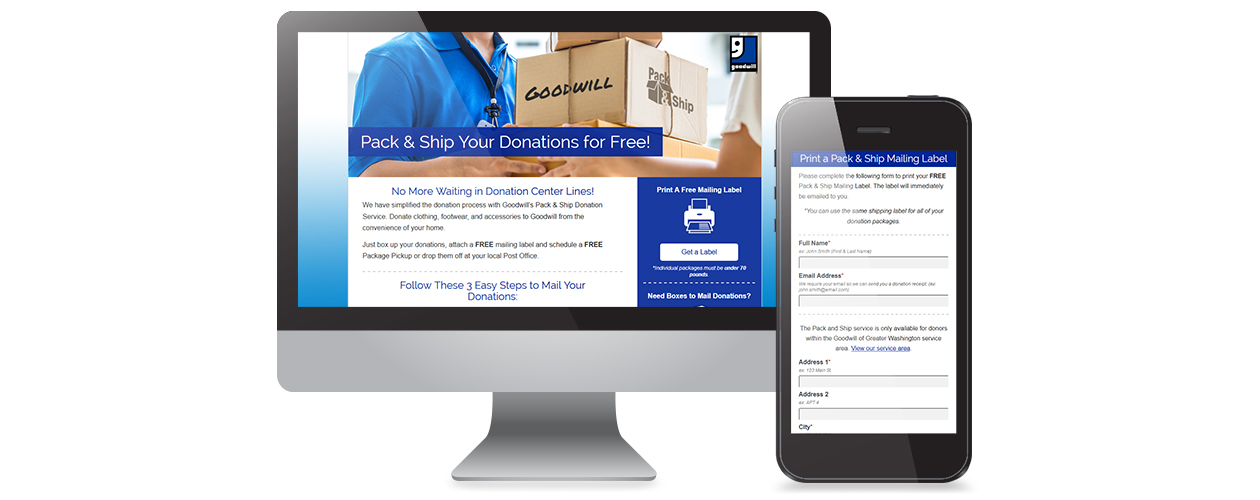
Experience Strategy Do Less & Donate MoreThe donation shipping experience needed to take less time and be more convenient than the traditional donation process. This pilot needed to encourage donors to ship their small- and medium-sized donations to Goodwill rather than dropping them off at a local competitor’s donation box.
I created the following flowcharts to illustrate user paths, technology systems and operational processes. These helped other team members and executives understand how the pilot would operate.
Donation Process
For the donor, the process was simple: go online, fill out a form, print a free shipping label and tape the label to the donation box. Then they had the option to either schedule a free pick-up or drop their donations off at their local post office.This user path illustrates the process a donor experiences when they use the pilot to ship donations.
Shipping Technology
Out of all of the shipping services I researched, the USPS Merchandise Return Services (MRS) was the best system for the pilot. The MRS labels came at no cost to the donor, and we could use the system’s API to build a custom user interface. USPS also offered free home pick-up services and had convenient post office locations for donors to easily ship their donations.This diagram shows the MRS technology and user data flow in relation to the user and donation shipping process. This flowchart was shared with the developer to help illustrate the integration systems.
Donation Evaluation Process
An important part of the service was evaluating the donations that came in through the pilot. The organization handled the cost of shipping for each package to make it free for the donor. To make sure the service was profitable, each donation was evaluated for its estimated resale value.The above flowchart illustrates the process for evaluating the estimated resale value of the donations. This flowchart helped the donations department understand how to evaluate the pilot to see if it could be profitable.
Receipting Process
Once a donation was received, we would email the donor a receipt for their donation. The receipt had to be sent after the donation was received because a proof of transaction had to be established.The above flowchart illustrates the operational process for how a donation receipt is sent to the donor. (user = personnel reviewing donations)
Testing & Evaluation
System & User FeedbackI focused most of the development resources on designing the front-end to make sure the donor had the most convenient and efficient experience. We received positive feedback from users who recognized the value in not having to drive donations to a donation center.
Manual Processes
During testing, I noticed there were a few manual processes on the operational side of the pilot that could become difficult to maintain if the pilot had high participation. These processes could be developed into an automated system to help improve donation processing efficiency. The manual processes included:
- Documenting donation information
- Combining donation information with donor data
- Emailing donation receipts to donors
Unfortunately, the limited budget prevented us from developing these processes. The plan to build out the pilot’s back-end experience was shelved until the pilot was deemed profitable.
System Data Blind Spots
Once there were packages coming through the system, I noticed a gap in information.The MRS system was unable to associate in-route packages with the donors. Without this data we could not gather the following information:
- The drop-off percentage between downloading and actually sending a package,
- If a packages were lost in the mail,
- The average time it took for a package to be shipped from the time the label was downloaded and
- The average number of days it took a package to be delivered.
This data was not crucial in evaluating the pilot, but it could have led to useful user insights. For example, we could have sent email reminders to donors who downloaded a label but had not shipped a package after a specific period of time.
Printers
A common concern from users was the fact that not everyone had access to a printer at home to print the shipping label.“Does it make sense to offer a service that not everyone will be able to use?”
~Anonymous Beta TesterThis was a legitimate concern, and I had to remind users and executives that the goal of this pilot was not to replace the current donation process. Instead, the pilot was designed to target a specific demographic of donors and offered an additional way to donate.
This justification, along with the low investment costs, kept the pilot alive.
Reflection My TakeawaysThe pilot has the potential to succeed on many levels. The service added convenience for the donor, opened up a new demographic of donors and gave the organization an edge over competitors.
I enjoy working on innovative projects that make life easier for the customer. This pilot was particularly compelling because we reimagined how used goods are donated, which has remained largely unchanged for decades.
